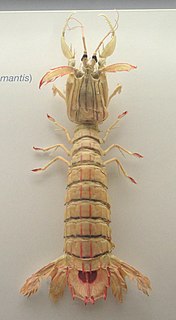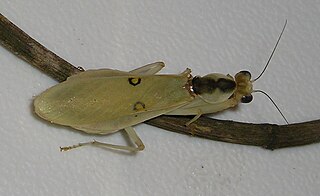
Mantis shrimp, or stomatopods, are carnivorous marine crustaceans of the order Stomatopoda, branching from other members of the class Malacostraca around 340 million years ago. Mantis shrimps typically grow to around 10 cm (3.9 in) in length, while a few can reach up to 38 cm (15 in). A mantis shrimp's carapace covers only the rear part of the head and the first four segments of the thorax. Varieties range in color from shades of brown to vivid colors, with more than 450 species of mantis shrimps being known. They are among the most important predators in many shallow, tropical and subtropical marine habitats. However, despite being common, they are poorly understood, as many species spend most of their lives tucked away in burrows and holes.

Squilla mantis is a species of mantis shrimp found in shallow coastal areas of the Mediterranean Sea and the Eastern Atlantic Ocean: it is also known as "pacchero" or "canocchia". Its abundance has led to it being the only commercially fished mantis shrimp in the Mediterranean.

The genus Mantis is in the family Mantidae, of the mantis order Mantodea.

Choeradodis is a genus of praying mantises with common names such as shield mantis, hood mantis, and leaf mantis because of their extended, leaf-like thoraces. The distinguishing characteristic of Choreododis from which it takes its common names is a laterally expanded thorax. This adaptation for the purpose of camouflage, as well as a rounded wing case and a habit of staying relatively flattened, aid its leaf mimicry.
Statilia apicalis is a far-ranging species of mantis found in Asia, Africa, and Oceania.

Hierodula patellifera, common name giant Asian mantis, Asian mantis, Indochina mantis or Harabiro Mantis, is a species of praying mantis belonging to genus Hierodula.

Dead leaf mantis is a common name given to various species of praying mantis that mimic dead leaves. It is most often used in reference to species within genus Deroplatys because of their popularity as exotic pets. Examples include D. desiccata, D. lobata, and D. philippinica. Other species to which the term may apply include Acanthops falcataria, A. falcata, and Phyllocrania paradoxa.
Acromantis australis, common name island mantis, is a species of praying mantis found in Australia, the Aru Islands, New Guinea, and Roon.

Choeradodis stalii is a species of praying mantis with common names that include tropical shield mantis, hooded mantis, and leaf mantis. It is found in Brazil, Ecuador, French Guiana, Panama, and Peru.

Leaf mantis is a common name for certain praying mantises including:
Shield mantis, hood mantis and leaf mantis are common names for certain praying mantises with an extended thorax aiding it in camouflage and leaf mimicry. The terms are used for species in the following genera:

Rhombodera is a genus of praying mantises native to Asia and possessing common names such as shield mantis, hood mantis, and leaf mantis because of their extended, leaf-like thoraxes.

Tamolanica is a genus of praying mantises native to Asia. They have common names such as shield mantis, hood mantis, and leaf mantis because of their extended, leaf-like thoraxes. The following species are recognised in the genus Tamolanica:
Asiadodis is a genus of praying mantises native to Asia and possessing common names such as shield mantis, hood mantis, and leaf mantis because of their extended, leaf-like thoraxes.

Chloroharpax is a genus of praying mantis in the family Hymenopodidae. The genus is monotypic, being represented by a single species, Chloroharpax modesta, commonly called the Nigerian flower mantis, and is found across West Africa.

Mantises are an order (Mantodea) of insects that contains over 2,400 species in about 460 genera in 33 families. The largest family is the Mantidae ("mantids"). Mantises are distributed worldwide in temperate and tropical habitats. They have triangular heads with bulging eyes supported on flexible necks. Their elongated bodies may or may not have wings, but all Mantodea have forelegs that are greatly enlarged and adapted for catching and gripping prey; their upright posture, while remaining stationary with forearms folded, has led to the common name praying mantis.

Orthodera is a genus of praying mantises that can be found in Australia and Southeast Asia, with one species said to be the only native species of mantis of New Zealand.

The Hierodulinae are a subfamily of praying mantids, originally used by Brunner von Wattenwyl. It was restored as part of a major revision of mantid taxonomy, and now contains genera previously placed elsewhere in the family Mantidae.
Tricharia vainioi is a species of foliicolous lichen in the family Gomphillaceae. It is widely distributed, having been recorded in Africa, Asia, Australia, Central and South America.














